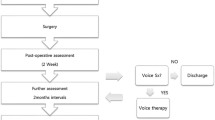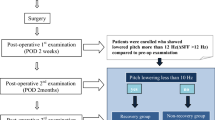Abstract
Background
We used voice analysis and clinicopathological factors to explore the prognosis of unilateral vocal fold paralysis after thyroid surgery.
Methods
The medical records of 63 females who developed unilateral vocal fold paralysis after thyroidectomy were reviewed. All patients were divided into two groups: those who recovered from vocal fold paralysis and those who did not. We analyzed clinical parameters and voice analysis results in a search for correlations with recovery from paralysis.
Results
Of the 63 patients, 37 (58%) recovered from paralysis. A small tumor size, incomplete paralysis, the absence of arytenoid tilting, no compensatory movement of the normal side, lower postoperative shimmer, a higher postoperative maximum phonation time (MPT), and lower postoperative subglottic pressure correlated significantly with recovery from vocal fold paralysis. Multivariate analysis confirmed that the absence of compensatory movement of the normal side on videostroboscopy was independently prognostic. A postoperative MPT of 6.86 appeared to be optimal for prediction of recovery. Most patients recovered within 6 months, but those with incomplete paralysis recovered about 3 months earlier. At the 12-month follow-up, the thyroidectomy-related voice questionnaire scores had returned to preoperative values in only 12 patients (19.0%); 51 patients (81.0%) did not fully recover.
Conclusion
Compensatory movement of the normal side evident on videostroboscopy was a poor prognostic factor. Voice analysis can be helpful in counseling vocal fold paralysis patients after thyroidectomy, and early intervention may be considered in patients who are expected to have a poor prognosis.
Similar content being viewed by others
References
Takano S, Nito T, Tamaruya N, Kimura M, Tayama N (2012) Single institutional analysis of trends over 45 years in etiology of vocal fold paralysis. Auris Nasus Larynx 39:597–600
Yamada M, Hirano M, Ohkubo H (1983) Recurrent laryngeal nerve paralysis. A 10 year review of 564 patients. Auris Nasus Larynx 10:S1–S15
Grosheva M, Wittekindt C, Pototschnig C, Lindenthaler W, Guntinas-Lichius O (2008) Evaluation of peripheral vocal cord paralysis by electromyography. Laryngoscope 118:987–990
Francis DO, McKiever ME, Garrett CG, Jacobson B, Penson D (2014) Assessment of patient experience with unilateral vocal fold immobility: a preliminary study. J Voice 28(5):636–643
Paniello Randal C, Park Andrea M, Neel K (2015) Bhatt recurrent laryngeal nerve recovery patterns assessed by serial electromyography. Laryngoscope 126:651–656
Rickert SM, Childs LF, Carey BT, Murry T (2012) Laryngeal electromyography for prognosis of vocal fold palsy: a meta-analysis. Laryngoscope 122:158–161
Guha K, Sabarigirish K, Singh SK, Yadav A (2014) Role of laryngeal electromyography in predicting recovery after vocal fold paralysis. Indian J Otolaryngol Head Neck Surg 66(4):394–397
Hong KH, Jung KS (2011) Arytenoid appearance and vertical level difference between the paralyzed and innervated vocal cords. Laryngoscope 111:227–232
Yumoto E, Oyamada Y, Nakano K, Nakayama Y, Yamashita Y (2004) Three-dimensional characteristics of the larynx with immobile vocal fold. Arch Otolaryngol Head Neck Surg 130:967–974
Caroline M, Joglekar SS, Mandel SM, Sataloff RT, Heman-Ackah YD (2012) The predictors of postoperative laryngeal nerve paresis in patients undergoing thyroid surgery: a pilot study. J Voice 26(2):262–266
Menon JK, Nair RM, Priyanka S (2014) Unilateral vocal fold paralysis: can laryngoscopy predict recovery? A prospective study. J laryngol Otol 128(12):1095–1104
Reiter R, Pickhard A, Sander S, Brosch S (2016) Prognostic relevance of mucosal waves in patients with unilateral vocal fold paralysis. Ann Otol Rhinol Laryngol 125(4):331–335
MacKinnon SE, Dellon AL, Hudson AR (1986) Chronic human nerve compression—a histological assessment. Neuropathol Appl Neurobiol 12(6):547–565
Solomon NP, Garlitz SJ, Milbrath RL (2000) Respiratory and laryngeal contributions to maximum phonation duration. J Voice 14:331–340
Zhou Z, Vincent F, Salle JY (2012) Acute stroke phase voluntary cough and correlation with maximum phonation time. Am J Phys Med Rehabil 91:494–500
Benninger MS, Crumley RL, Ford CN (1994) Evaluation and treatment of the unilateral paralyzed vocal fold. Otolaryngol Head Neck Surg 111:497–508
Giovanni A, Demolin D, Heim C (2000) Estimated subglottic pressure in normal and dysphonic subjects. Ann Otol Rhinol Laryngol 109(5):500–504
Ketelslagers K, De Bodt MS, Wuyts FL (2007) Relevance of subglottic pressure in normal and dysphonic subjects. Eur Arch Otorhinolaryngol 264(5):519–523
Chun BJ, Bae JS, Sun DI (2014) The therapeutic decision making of the unilateral vocal cord palsy after thyroidectomy using thyroidectomy-related voice questionnaire (TVQ). Eur Arch Otorhinolaryngol 272(3):727–736
Jeannon JP, Orabi AA, Bruch GA (2009) Diagnosis of recurrent laryngeal nerve palsy after thyroidectomy: a systematic review. Int J Clin Pract 63(4):624–629
Joliat GR, Guarnero V, Demartines N (2017) Recurrent laryngeal nerve injury after thyroid and parathyroid surgery: Incidence and postoperative evolution assessment. Medicine (Baltimore) 96(17):e6674
Author information
Authors and Affiliations
Corresponding author
Ethics declarations
Conflict of interest
The authors declare that they have no conflict of interest.
Rights and permissions
About this article
Cite this article
Choi, YS., Joo, YH., Park, YH. et al. Factors Predicting the Recovery of Unilateral Vocal Fold Paralysis After Thyroidectomy. World J Surg 42, 2117–2122 (2018). https://doi.org/10.1007/s00268-017-4440-6
Published:
Issue Date:
DOI: https://doi.org/10.1007/s00268-017-4440-6




